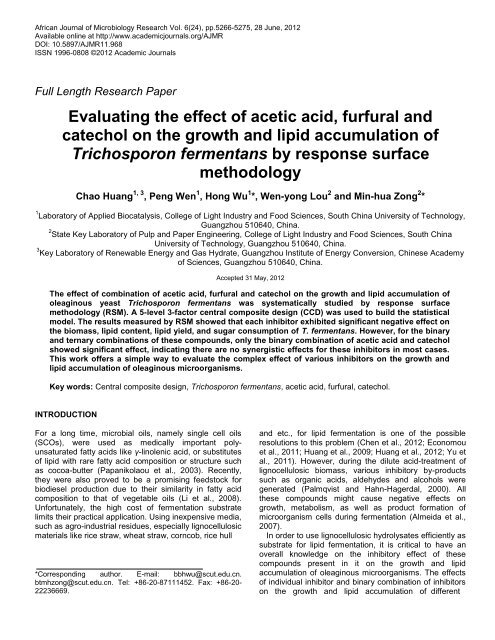Microbiology Research - Academic Journals
Microbiology Research - Academic Journals
Microbiology Research - Academic Journals
You also want an ePaper? Increase the reach of your titles
YUMPU automatically turns print PDFs into web optimized ePapers that Google loves.
African Journal of <strong>Microbiology</strong> <strong>Research</strong> Vol. 6(24), pp.5266-5275, 28 June, 2012<br />
Available online at http://www.academicjournals.org/AJMR<br />
DOI: 10.5897/AJMR11.968<br />
ISSN 1996-0808 ©2012 <strong>Academic</strong> <strong>Journals</strong><br />
Full Length <strong>Research</strong> Paper<br />
Evaluating the effect of acetic acid, furfural and<br />
catechol on the growth and lipid accumulation of<br />
Trichosporon fermentans by response surface<br />
methodology<br />
Chao Huang 1, 3 , Peng Wen 1 , Hong Wu 1 *, Wen-yong Lou 2 and Min-hua Zong 2 *<br />
1 Laboratory of Applied Biocatalysis, College of Light Industry and Food Sciences, South China University of Technology,<br />
Guangzhou 510640, China.<br />
2 State Key Laboratory of Pulp and Paper Engineering, College of Light Industry and Food Sciences, South China<br />
University of Technology, Guangzhou 510640, China.<br />
3 Key Laboratory of Renewable Energy and Gas Hydrate, Guangzhou Institute of Energy Conversion, Chinese Academy<br />
of Sciences, Guangzhou 510640, China.<br />
Accepted 31 May, 2012<br />
The effect of combination of acetic acid, furfural and catechol on the growth and lipid accumulation of<br />
oleaginous yeast Trichosporon fermentans was systematically studied by response surface<br />
methodology (RSM). A 5-level 3-factor central composite design (CCD) was used to build the statistical<br />
model. The results measured by RSM showed that each inhibitor exhibited significant negative effect on<br />
the biomass, lipid content, lipid yield, and sugar consumption of T. fermentans. However, for the binary<br />
and ternary combinations of these compounds, only the binary combination of acetic acid and catechol<br />
showed significant effect, indicating there are no synergistic effects for these inhibitors in most cases.<br />
This work offers a simple way to evaluate the complex effect of various inhibitors on the growth and<br />
lipid accumulation of oleaginous microorganisms.<br />
Key words: Central composite design, Trichosporon fermentans, acetic acid, furfural, catechol.<br />
INTRODUCTION<br />
For a long time, microbial oils, namely single cell oils<br />
(SCOs), were used as medically important polyunsaturated<br />
fatty acids like γ-linolenic acid, or substitutes<br />
of lipid with rare fatty acid composition or structure such<br />
as cocoa-butter (Papanikolaou et al., 2003). Recently,<br />
they were also proved to be a promising feedstock for<br />
biodiesel production due to their similarity in fatty acid<br />
composition to that of vegetable oils (Li et al., 2008).<br />
Unfortunately, the high cost of fermentation substrate<br />
limits their practical application. Using inexpensive media,<br />
such as agro-industrial residues, especially lignocellulosic<br />
materials like rice straw, wheat straw, corncob, rice hull<br />
*Corresponding author. E-mail: bbhwu@scut.edu.cn.<br />
btmhzong@scut.edu.cn. Tel: +86-20-87111452. Fax: +86-20-<br />
22236669.<br />
and etc., for lipid fermentation is one of the possible<br />
resolutions to this problem (Chen et al., 2012; Economou<br />
et al., 2011; Huang et al., 2009; Huang et al., 2012; Yu et<br />
al., 2011). However, during the dilute acid-treatment of<br />
lignocellulosic biomass, various inhibitory by-products<br />
such as organic acids, aldehydes and alcohols were<br />
generated (Palmqvist and Hahn-Hagerdal, 2000). All<br />
these compounds might cause negative effects on<br />
growth, metabolism, as well as product formation of<br />
microorganism cells during fermentation (Almeida et al.,<br />
2007).<br />
In order to use lignocellulosic hydrolysates efficiently as<br />
substrate for lipid fermentation, it is critical to have an<br />
overall knowledge on the inhibitory effect of these<br />
compounds present in it on the growth and lipid<br />
accumulation of oleaginous microorganisms. The effects<br />
of individual inhibitor and binary combination of inhibitors<br />
on the growth and lipid accumulation of different

















